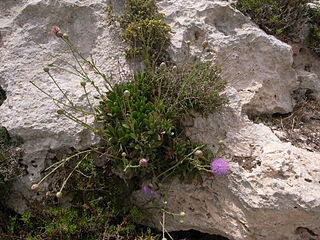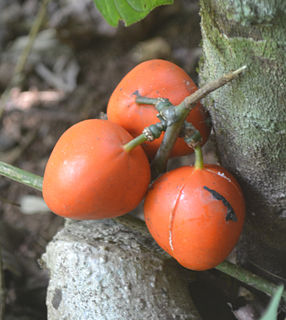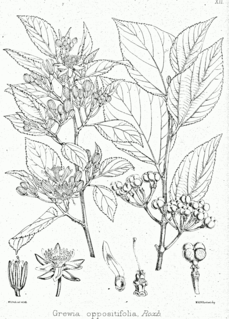
Strychnos is a genus of flowering plants, belonging to the family Loganiaceae. The genus includes about 100 accepted species of trees and lianas, and more than 200 that are as yet unresolved. The genus is widely distributed around the world's tropics and is noted for the presence of poisonous indole alkaloids in the roots, stems and leaves of various species. Among these alkaloids are the well-known and virulent poisons strychnine and curare.

Averrhoa is a genus of trees in the family Oxalidaceae, of the order Oxalidales, named after Averroes, a 12th-century astronomer and philosopher from Al-Andalus.

Momordica balsamina is a tendril-bearing annual vine native to the tropical regions of Africa, introduced and invasive in Asia, Australia, Central America, and North America, where they have been found in some parts of Florida. It has pale yellow, deeply veined flowers and round, somewhat warty, bright orange fruits, or "apples". When ripe, the fruits burst apart, revealing numerous seeds covered with a brilliant scarlet, extremely sticky coating. The balsam apple was introduced into Europe by 1568 and was used medicinally to treat wounds. In 1810, Thomas Jefferson planted this vine in his flower borders at Monticello along with larkspur, poppies, and nutmeg.
Ok.hsla caillei, the West African okra, is a plant species in the family Malvaceae. It occurs in humid areas of West and Central Africa, where it is used as a vegetable. It originated as an allopolyploid hybrid of Abelmoschus esculentus and A. manihot, and is often mistaken for either of those two plants. It was officially described elevated to the status of a species in 1988. The same hybrid was produced experimentally in Japan where it is known as Abelmoschus glutino-textile.

Lagurus is a genus of Old World plants in the grass family, native to the Mediterranean Basin and nearby regions, from Azores and the Canary Islands to Crimea and Saudi Arabia. It is also naturalized in Australia, New Zealand, Ireland and Great Britain, and scattered locations in the Americas. The only known species is Lagurus ovatus, commonly called hare's-tail, hare's-tail grass or bunnytail. It is also grown as an ornamental plant for its attractive flower panicles.

Cheirolophus crassifolius, the Maltese centaury, Maltese rock-centaury or Widnet il-Baħar, is a species of flowering plant in the family Asteraceae. It is endemic to Malta, where it has been the national plant of Malta since 1973. Its natural habitats are cliffs and coastal valleys. It is threatened by habitat loss.
Dichaetaria is a genus of South Asian plants in the grass family.
Micranthes howellii is a species of saxifrage known by the common name Howell's saxifrage. It is endemic to the Klamath Mountains of southern Oregon and northern California, where it grows in moist, rocky habitat. It is a perennial herb growing from a caudex, usually with a rhizome system. It produces a basal rosette of leaves with rounded or oval blades edged with dull or sharp teeth or scalloping. Each leaf is up to 6 centimeters long, thick and fleshy, and borne on a short petiole. The inflorescence arises on an erect peduncle up to 20 centimeters tall. An array of branches bear several flowers with small white petals.

Thunbergia fragrans, the whitelady is a perennial climbing twiner in the genus Thunbergia, native to India and Southern Asia.
Balanites glabra is a species of tree or shrub, classified either as a member of the Zygophyllaceae or the Balanitaceae. This tree is native to East Africa.
Balanites pedicellaris, the small green-thorn or small torchwood is a small tree or shrub from Sub-Saharan Africa. It is a member of the caltrop family Zygophyllaceae.

Platanthera hookeri, otherwise known as Hooker's orchid or Hooker's bog orchid, is a perennial wildflower in the genus Platanthera that can be found in temperate regions of North America ranging from Iowa to Newfoundland.

Meyna laxiflora is a species of flowering plant in the family Rubiaceae. It has a world-wide distribution across tropical and subtropical regions.

Adenia hondala, commonly known as hondala is a large, tuberous, woody climber which scrambles over other plants. It is found in the Indian subcontinent, including Sri Lanka, and in southeastern Asia. The tuber and the fruit are used as herbal remedies and the plant is used as a cure for snake bites. The caterpillars of several species of butterfly feed on this plant; these include the tawny coster, the clipper, the common cruiser and the Tamil lacewing.
Barteria fistulosa is a species of tree in the family Passifloraceae, native to tropical Central Africa. The tree has an association with an aggressive species of ant with a very painful sting, which lives in its hollow branches and twigs, and gives rise to its common name of "ant tree".

Catabrosa aquatica, called brookgrass, water whorl-grass, water whirlgrass and water hairgrass, is widespread species of semi-aquatic grass in the genus Catabrosa, native to the most of the non-tropical northern hemisphere, and to southern Chile and Argentina. As its scientific and common names suggest, it prefers to grow in wet areas, such as meadows, stream banks and lake shores.

Grewia oppositifolia is a currently accepted species of flowering plant in the family Malvaceae, native to the Indian Subcontinent. It has many similarities with and may be a synonym of Grewia optiva ; certainly they share the same range, habitat, appearance, growth form, common names, and local uses as a source of forage, timber, fruit, and medicine.
Landolphia buchananii is a liana within the Apocynaceae family. It is sometimes called Nandi rubber in English and known locally as Mugu among Kikuyus. Occurs in savannahs and montane forests in East Africa and Southeastern Nigeria.
Landolphia dulcis is a climbing shrub or liana within the Apocynaceae family.
Hugonia planchonii is a liana with bright yellow flowers that are short-lived and stems producing alternate hooks that is endemic to countries in Tropical West Africa but also occurs in Cameroon and Gabon. It is within the Linaceae family.











